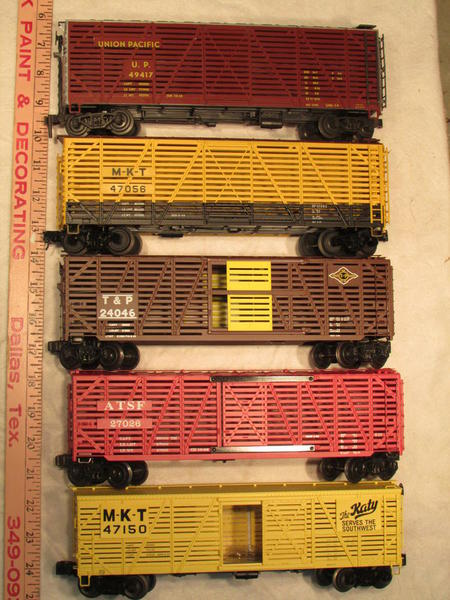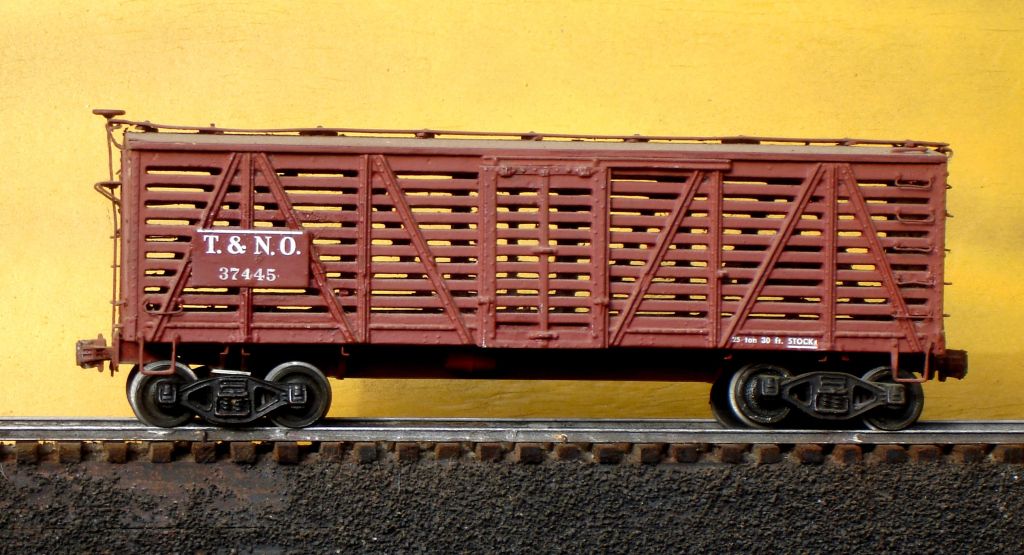From the 1800s to the 1980s stock cars were used to transport live stock on American railroads. Most moves were from rural farm and ranching areas toward the cities where the animals were processed. In the earliest days animals were often shipped for slaughter very close to the points where they were consumed. After the Civil War several midwestern cities developed large stock yard complexes where cattle, hogs and sheep were shipped in and sold to eastern buyers or bought by local slaughter houses. The development of the ice bunker refrigerator car allowed meat packers in the mid west to process animals closer to the region in which they were raised and ship only dressed meat to markets in the east. The largest stock yards were located in Chicago and Kansas City.
Both the Chicago and Kansas City stock yards saw their peak years in the 1920s with thousands of animals arriving by rail every day. After the animals were unloaded, fed, watered and sold the live stock was either loaded back into stock cars for new destinations or sent to packing houses in the complex. The packing houses would then ship dressed meat out in refrigerator cars and would also ship out hides to tanneries in older box cars dedicated to that service.
After WW II the large stock yards went into rapid decline as the meat packing industry decentralized. New, smaller packing houses were built closer to farms and ranches and typically received their animals by truck. They shipped their products to market in mechanically refrigerated railroad cars and, ever more frequently, in mechanically refrigerated trucks. While railroads may have missed the revenue that the centralized meat packing industry had brought to them they were happy to be without the need to provide the special handling that live stock required. Stock cars were typically placed at the head of a train to reduce the chances of injury to animals due to slack action. Live stock also required special handling to provide water or feed and exercise after a legally mandated number of hours in a stock car. In fact, live stock received that humane protection before railroad workers, leading some of today's railroaders to still refer to their hours of service limits as the “hog law.” Many railroads also had maintained drovers cars to provide a place to ride for stockmen accompanying their animals to market.
Today we have five O scale models of stock cars. Each is a little different and represent cars that may have been built or rebuilt from the late 1920s to the 1960s. The first two reviewed here, by Lionel and K-Line, have dimensions similar to a USRA box car and many traditional O gauge freight cars. The models from Atlas, MTH and Weaver represent post WW II cars with larger dimensions similar to 40 foot AAR and PS-1 box cars.
The Lionel Standard O Stock Car is based on a prototype built by American Car and Foundry in the pre-WW II era. The Lionel model was introduced in the 2002 Volume 1 catalog and has a wooden roof and 4/4 Dreadnaught ends. It also features a die-cast floor and underframe that contributes to its 19 ounce weight and makes it the heaviest of these O scale models. The extra weight adds to the operating quality of the car when placed at the head end of a freight.

The K-Line K763 stock car has a Murphy rectangular panel roof and 4/4 Dreadnaught ends, features common on cars built from the 1930s until the mid 40s. It has seen continued production under the K-Line by Lionel banner.

The Atlas Trainman stock car shares its Stanray diagonal panel roof and R+3/4 improved Dreadnaught ends with the Trainman 40 foot box cars and are typical of cars built in the late 1940s into the 1950s. It was announced along with the rest of the initial Trainman products in April 2005.

The MTH Premier Steel Sided stock car debuted in the 1999 volume 3 catalog. It features a Stanray diagonal panel roof and 4/5 Dreadnaught ends. The ends and roof are not shared by any other 40 foot freight car in the MTH line of O scale models.

Weaver's 40 foot stock car shares its roof and ends with their post WW II era 40 foot PS-1 box car.

If you have any questions please ask. If you have more information please share. And if you have photos of your O scale stock cars on your model railroads, let's see them! ![]()
Information on other types of O scale freight cars can be found at the link below.











